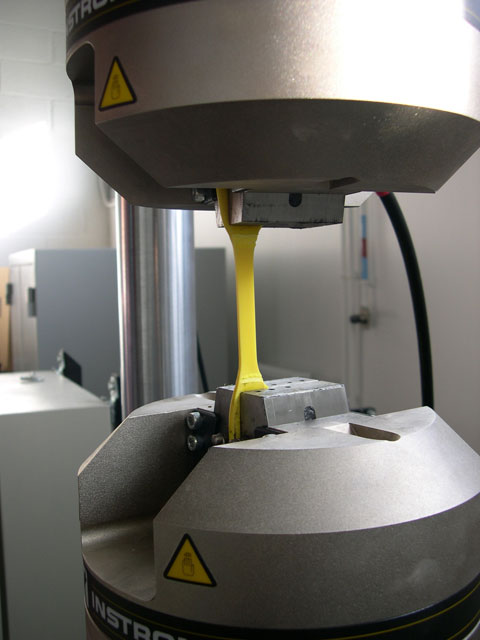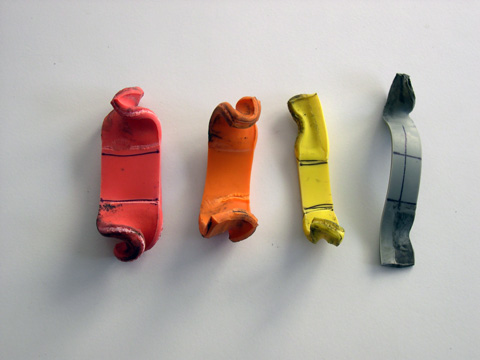
UPDATE [20/05/2013]: Resistances of the Sci-Sport elastic bands indicated in this article are no longer valid. To obtain the current values, please go to the following article : Cliquez ici.

Figure 1. Stretch of the S elastic Band sample on a servohydraulic test machine (Instron 8801).
As we previously explained in the review "Elastic bands : From science to practice", the elastic resistance is a variable resistance. Indeed, the more the elastic is stretched the greater the resistance opposed to this stretch is.
In addition to this intrinsic mechanical characteristic, the resistance of elastic bands is also related to various mechanical and chemical processes that allow the latex to take shape. Therefore, it is not uncommon for two sets of elastic bands, of the same dimensions but produced at two distinct moments, to have not quite the same mechanical properties and therefore not quite the same resistances.
To answer this problematic, we have tested the mechanical properties of Sci-Sport elastic bands accurately and reliably in laboratory. Appointment was made at the Technological Hall of the University of Reims Champagne-Ardenne, in the G.R.E.S.P.I. laboratory with Alexandre Gacoin, researcher in Civil Engineering.
The protocol consisted in testing 4 samples of elastic bands of different sizes :
Each 7 cm long sample was placed on a servohydraulic test machine (Instron 8801). The area to be tested was only 2 cm, 2.5 cm was needed at the top and bottom for the sample to be fixed in the jaws of the device (Fig. 1). Then, the machine pulled the sample at a constant speed of 1 mm/s. The measurement range was approximately 15 cm (Fig. 2) and for each test the force versus strain was recorded.

Figure 2. Stretching of elastic band during a tensile strength test.
The results are presented in Table 1, and describe the resistance produced (R, in kg) by the elastic bands opposite to the deformation (in % of the rest length). Since the Sci-Sport elastic bands are in a loop, it was necessary to multiply the measured values by 2. To obtain R, we had to refer to the Newton's second law and to divide the force (F, in N) by gravitational acceleration (g, in m/s).


Figure 3 shows the force produced as a function of the deformation for each sample. The profile of the curves is characteristic of the behavior of polymers at stretching. We will come back in more detail on the mechanical behavior of polymers in the review dedicated to elastic bands. Just be aware that from 0 to about 500%, the stretching of the latex band is mainly due to the alignment of the macromolecules that make up the material. When the elastic band is at rest, the macromolecules are like twisted spaghetti, stretching allows them to line up next to each other. Beyond 500% deformation, the stretching of the band causes the tension between the macromolecules, which in time will lead to the breaking of the band.

Figure 5. The 4 samples tested during tensile tests.
During these tests, we were unable to break the samples of elastic bands. The reason is simply due to the limited measuring range of the tensile testing machine that is not specifically designed for polymers. However, you will noticed in different figures, and particularly in Figure 4, that white areas appeared on the bands at the fixation points. These zones represent zones of rupture and are due to the damage of the bands by the pressure force of the jaws. Nevertheless, none of the samples showed any break zones on its central part up to 650% deformation, ie a stretch of 6.5 times its initial length (Fig. 5).
It is certain that the knowledge of the exact opposite resistance for a given stretch is not useful for people who do not research the optimization of performance. Indeed, the color code and the dimensions of the elastic bands are generally sufficient to identify the difficulty that a person will encounter. However, this information becomes interesting for a performance purpose. For example, for a squat exercise, if a physical trainer decides to add an elastic resistance in addition to the load of the bar, he will know what will be the final resistance at the top of the movement by simply knowing the range of motion of the bar.
The most common use of the elastic bands is between 100 and 300% of deformation according to the exercises practiced. Of course, consider doubling the values given in Table 1 if for some reason you double the bands. In the same way, add the resistances if you combine in the same exercise different elastic bands.
We remind you that you can quote articles by limiting your quotation to 200 words maximum and you must include a nominative link to this one. Any other use, especially copying in full on forum, website or any other content, is strictly prohibited. In doubt, contact us.
Copyright © 2011-2024 - www.sci-sport.com - All rights reserved